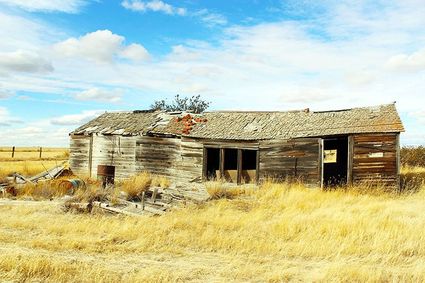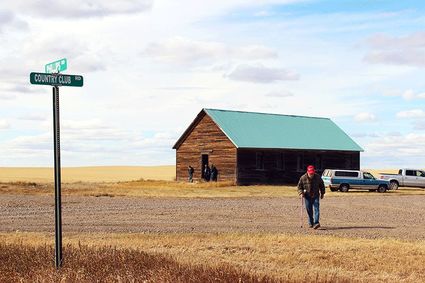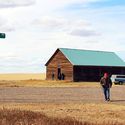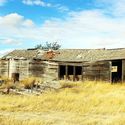Turner's Country Club hosted gatherings for Little Jewell community
October 4, 2017
By Steve Edwards
BCJ News
Reporter's note: My interest in the Country Club hall on the Big Flat started when a fellow diner asked Ed Snider, at a Harlem Senior Center dinner, "Do you remember the time you took us to the Turner Country Club?" My ears perked up because I'd never heard about a country club near Turner or anywhere else on the Big Flat. After some more questioning Ed told me, "The Country Club is a place with quite a history. Contact Richard Hickel up in Turner and he'll tell you all about it."
I did call Hickel, a retired farmer who happened to be helping his son, Steve, with harvest. Richard said, "Wait until harvest is done, then give me a call." I kept checking and finally Richard said, "Meet me at the Turner store in the coffee room. I'll have some other guys who also have information. We'll tell you what we can remember, then take you out there so you can see the Country Club for yourself."
I met Richard Hickel, Jack Van Voast, Norm Spoonheim and, joining us a little later, Richard's son, Steve. We drank coffee and they shared information about the old hall. Of special interest were the personal remembrances about the Country Club hall and its history in the community of Little Jewell. Little Jewell was pioneer community southeast of Turner. After a post office was secured in a homesteader's cabin, the community saw the need for a place to gather for events and launched the building of what came to be known as the Country Club.
The story of the Country Club is one part of the story of Little Jewell. That frontier community is now only a memory marked by a falling down homestead cabin that served as store and post office for a time. Little Jewell disappeared, but the place they built for gatherings, more than a century ago, is still standing. Here's a bit of the story of the Country Club at Little Jewell.
The Little Jewell Community in the early 1900's
The story of the Little Jewell community, named after a spring in a nearby coulee, is well documented in several local history books produced by folks up on the Big Flat. The general timeline of the community began in 1913 when a homesteader named Frank Allen added a post office and small store to his homestead. The post office stayed open until 1925 when mail was re-routed through Lost Lake, another frontier community in Phillips County to the south.
Dorothy Allen, the wife of the postmaster and store owner, had been a school teacher before she married Frank. She began to tutor the children of Little Jewell. A few years later locals organized the first school board in the community.
In the meantime, a momentous decision was made by residents in the area. Recognizing the "need for more opportunities for social gatherings and events" work was begun on a "large hall" that became known as the Country Club. The Country Club became the centerpiece of the Little Jewell community for half a century.
The Country Club was completed around 1913-14
Steve Hickel, who has done a lot of research about the Country Club and schools in the area, said he believes 'shares' were sold to raise the capital to buy building materials for the new community hall. Jess Calvert donated the land for the hall. A photo taken of the "staking" of the building (basically laying out the shape) is undated but shows a number of locals involved in the start of the new hall. Hickel said, "The building was completed sometime in 1913 or '14."
The building, sitting on a patch of prairie that likely looks about the same now as when it was completed, still stands. Of wood construction, it is 30 by 60 feet in size. The main door is at the south end of the building and there's a rear door at the northeast corner. The rear door is located for access to a raised stage that runs the width of the rear portion of the building. There was never any plumbing or electricity added to the hall and no formal kitchen facilities.
Standing inside, the rafters supporting the roof are visible. Some lathing on the ceiling caused one of my tour guides to speculate, "They must have had some sort of cloth or covering below the rafters to keep the heat down where it was needed in the winter." Jack Van Voast said, "I remember there was a cook stove on the stage at one time. Down on the floor there was also one of those old pot-bellied stoves. I guess the stove on the floor was the heat source in the winter."
A crawl space/storage area is still accessible from the outside rear of the building. Richard Hickel said of the crawl space, "I've poked around under there and there's all sorts of beer cans that span quite a period." He reached down and picked up an empty can of Great Falls Select. He added, "This was a very popular brand with locals." Doing some internet checking, I found the original Great Falls brewery was sold to a Portland concern in 1968. The tour guides believed the last dances, and functions at the hall, were discontinued in the early 1960's, about the time the regional brewery sold.
About 25 years ago the Turner Lions Club 'stabilized' the building and planned to move it near the park in Turner. They tinned the roof and, after straightening the building with external cables, attached plywood to the internal walls and part of the ceiling. Plans to move the building were abandoned. As far as anyone in the group could recall, the Lions' project was the last official event at the old hall.
The Country Club served many purposes
Beginning in the spring of 1915, the Country Club was used to hold summer session school for Little Jewell's children. A school board was elected and a separate school building was completed in 1920, just across the road from the Country Club. Norm Spoonheim began at the Little Jewell school in 1940. He recalled "about 7-8 students" in the school, and more when his older siblings went to school. There was a small barn behind for horses and the teacher lived at the school. Spoonheim laughed when he remembered "hiding from the teacher in the storage area under the Country Club."
As best can be determined, students in the Little Jewell area always attended summer school sessions. It was not clear when the summer sessions actually began each spring, but Spoonheim recalled, "We would have an early Christmas party at school, then be off until the next spring." My local guides said summer sessions were for the safety of the children going to and from school. Steve Hickel said, "Early on there was an incident where a child nearly died going to school in a storm. Folks sent kids to school when the weather was milder." The school closed in 1942 and the building was eventually moved in to Turner for use as a classroom, then torn down when the present school was built.
In June, 1916, the Harlem newspaper reported about a huge Catholic wedding held at the hall, likely one of the first weddings held there. In part the story read, "The Country Club...has been used for every sort of a meeting place in the past, was on this occasion transformed into a sacred house of worship. An altar has been erected for the occasion...." The groom, Otto Meyer, was earlier pictured holding the 'stake' when the original building was laid out.
Another popular event my local guides recalled was 'basket socials.' At a basket social ladies would prepare a picnic lunch, then the men would bid on the basket, which included lunch with the lady who made the lunch. Asked if the bidders knew which lady made which basket, one commentator said, "If you had a special girlfriend you wanted to have lunch with you made it your business to know which basket she brought."
The stage in the Country Club was used to present plays performed by local actors. Steve Hickel shared copies of a Harlem newspaper from 1914 that described a play presented at the old hall entitled "A Pair of Artists." The three act comedy dealt with a serious issue at the time, women's suffrage. The presentation at the Country Club got such rave reviews that the players were invited to present the play in the Harlem Opera House.
What most stood out in the minds of my guides was the dances held at the hall. Several, who were taken as children to the dances with their parents, commented, "Sometimes the dances would go all night. They would roll the kids up in blankets and coats and put us to bed wherever there was a place." Another said, "It was safer to stay and dance all night than try to go home in the dark. There were no fences to follow early on." The dances continued until sometime in the 1960's when the guides said, "Someone would bring a portable plant for light and power. No one ever seemed to see a need for electricity."
What's the future of the Turner Country Club?
As my guides walked me around the old hall, several comments were made about the status of the building. One said, "Look at the concrete foundation. It's over 100 years old and like new." The front door was gone and there was evidence some livestock might have been inside. Another guide said, "The floors must still be strong to support cows." It was impressive that a building that old, and not purposefully maintained, was in such remarkable shape.

This is a recent photo of Frank Allen's homestead in the Little Jewell area southeast of Turner. The community took its name from a spring in a nearby coulee. Allen added a store and operated the post office, from 1913 to 1920, in one part of his homestead. The Little Jewell School, across the field from Allen's homestead, was opened in 1920 and operated until 1942. The school building was moved in to Turner and used as a classroom until the present school was built.
At one point I heard this comment: "If we replaced the door and only a few of the windows, it would still be some great, usable space." Twenty-five years ago, when the Lions Club stabilized the building to move it, the plan was to put it near the town park in Turner, where it could be used for events that needed to come in out of the weather. That move was rebuffed by some locals.
We made one more stop, before concluding the tour of Little Jewell, at Frank Allen's old homestead. Jack Van Voast said, "Take a good look at it because it will likely be razed this winter." The old homestead was basically falling in, filled with the kind of detritus you would expect in an abandoned homestead. The falling in homestead is the last remaining vestige of Little Jewell.
Steve Hickel represents the next generation after the guides who took me around. His family is very connected to the area and the old hall. I asked him, after hearing the older guys' excitement about the possibilities for the old hall, if he thought there was a new role for the building. He just smiled and shrugged his shoulders. After standing strong for a century, the Country Club might still be repurposed out on the Big Flat.











